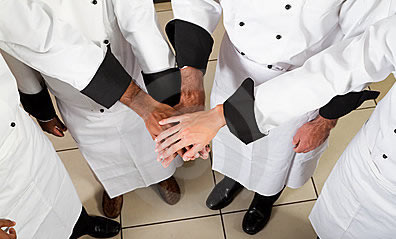
SIX COMMON MISPERCEPTIONS ABOUT TEAMWORK
In his article entitled ‘Six Common Misperceptions about Teamwork’, J. R Hackman – a Professor of Social and Organizational Psychology at Harvard University – brings to light a number of issues which are valid within kitchen teams and well worth taking a look at in this context.
Misperception #1: Harmony helps. Smooth interaction among collaborators avoids time-wasting debates about how best to proceed.
Actually: Quite the opposite, research shows. Conflict, when well managed and focused on a team’s objectives, can generate more creative solutions than one sees in conflict-free groups. So long as it is about the work itself, disagreements can be good for a team. Indeed, we found in our earlier research on symphony orchestras that slightly grumpy orchestras played a little better as ensembles than those whose members worked together especially harmoniously.
Notes for the kitchen: In this case many kitchens may be considered ahead of their time! There is no shortage or ego/stress/fatigue driven conflict in kitchens. What is most noteworthy here is that in order for the conflict to be productive it must be ‘well managed’. Much of the conflict that does exist within kitchens is poorly managed, with the higher ranks paying little attention and turning a blind eye towards ‘petty’ kitchen disputes. Perhaps creating a more positive form of rivalry based on competitiveness may be effective. Another idea may be encouraging the kitchen team to air disputes and resolve them in a more constructive setting such as during pre-service briefings. This may help to reduce ‘petty’ rivalries and disputes within the kitchen and allow the head chef to manage these issues more effectively.
Misperception #2: It’s good to mix it up. New members bring energy and fresh ideas to a team. Without them, members risk becoming complacent, inattentive to changes in the environment, and too forgiving of fellow members’ misbehaviour.
Actually: The longer members stay together as an intact group, the better they do. As unreasonable as this may seem, the research evidence is unambiguous. Whether it is a basketball team or a string quartet, teams that stay together longer play together better.
Notes for the kitchen: With such high staff turnover rates in most kitchens (and the hospitality industry as a whole), this is one of the most alarming of the 6 points. Chefs (of all ranks) require a number of weeks to fully become in tune with the work flow, menu, layout and systems in a new kitchen. In addition to the more formal, structured aspects of working in the kitchen, they must also work to find their place within the team, to prove themselves and become a productive member of the unit. In good kitchens new chefs also receive a certain degree of training specific to their position. All of this takes time and uses up kitchen resources, therefore when the average tenure is low, the return on investment on chefs is low. According the above misconception, high turnover also means that many kitchens are being held back as their team never fully matures to a point of achieving their optimal results.
Misperception #3: Bigger is better. Larger groups have more resources to apply to the work. Moreover, including representatives of all relevant constituencies increases the chances that whatever is produced will be accepted and used.
Actually: Excessive size is one of the most common–and also one of the worst–impediments to effective collaboration. The larger the group, the higher the likelihood of social loafing (sometimes called free riding), and the more effort it takes to keep members’ activities coordinated. Small teams are more efficient–and far less frustrating.
Notes for the kitchen: This point can be seen most clearly when you compare the kitchens of a restaurant that open 5 days per week and have one set of staff working 15+ hours a day together, verses a kitchen that is a 7 day-a-week operations and has a larger number of staff on multiple shifts with varied days off. Anyone who has worked in both types of kitchen will have seen that sense of comradery and team spirit in the smaller team is far stronger.
Misperception #4: Face-to-face interaction is passé. Now that we have powerful electronic technologies for communication and coordination, teams can do their work much more efficiently at a distance.
Actually: Teams working remotely are at a considerable disadvantage. There really are benefits to sizing up your teammates face-to-face. A number of organizations that rely heavily on distributed teams have found that it is well worth the time and expense to get members together when the team is launched, again around the midpoint of the team’s work, and yet again when the work has been completed.
Notes for the kitchen: In most cases, electronic technologies have not infiltrated kitchen communications as much as in other industries. So although this may not really be applicable to the kitchen, it is a note worthy point for senior chefs when dealing with other departments and suppliers etc.
Misperception #5: It all depends on the leader. Think of a team you have led, or on which you have served, that performed superbly. Now think of another one that did quite poorly. What accounts for the difference between them? If you are like most people, your explanation will have something to do with the personality, behavior, or style of the leaders of those two teams.
Actually: The hands-on activities of group leaders do make a difference. But the most powerful thing a leader can do to foster effective collaboration is to create conditions that help members competently manage themselves. The second most powerful thing is to launch the team well. And then, third, is the hands-on teaching and coaching that leaders do after the work is underway. Our research suggests that condition-creating accounts for about 60% of the variation in how well a team eventually performs; that the quality of the team launch accounts for another 30%; and that real-time coaching accounts for only about 10%. Leaders are indeed important in collaborative work, but not in the ways we usually think.
Notes for the kitchen: The head chef will always play a pivotal role in dictating the kitchen’s success, however it is interesting to take note of the importance placed on how well the team are formed. There seems to be a distinct absence of attention paid to this point when recruiting chefs. Staff are hired based on their experience, skill level etc, but less importance is placed on how effective they will be as part of the team.
Misperception #6: Teamwork is magical. To harvest its many benefits, all one has to do is gather up some really talented people and tell them in general terms what is needed–the team will work out the details.
Actually: It takes careful thought and no small about amount of preparation to stack the deck for success. The best leaders provide a clear statement of just what the team is to accomplish, and they make sure that the team has all the resources and supports it will need to succeed. Although you may have to do a bit of political maneuvering to get what is needed for effective collaboration from the broader organization, it is well worth the trouble.
Notes for the kitchen: Structured goals and adequate provision of resources and support are lacking in the majority of kitchens. Goals are not communicated clearly and chefs are expected to take up the job ahead of them and work towards accomplishing positive results for today, without being given any structured idea as to what the restaurants goals (non financial) are for the future. Resources and support are also lacking- in part due to the financial constraints of a kitchen and poor management skills.
Higher ranking chefs must begin to look at ways in which they can clearly communicate their goals and provide their team with a strong sense of direction. Ensuring that staff have the resources and support they require will allow the chefs to carry out their jobs more efficiently and maintain a high morale.
The misperceptions that are summarized in this post are explored in greater depth in J. Richard Hackman`s new book Collaborative Intelligence: Using Teams to Solve Hard Problems (Berrett-Koehler, 2011).

